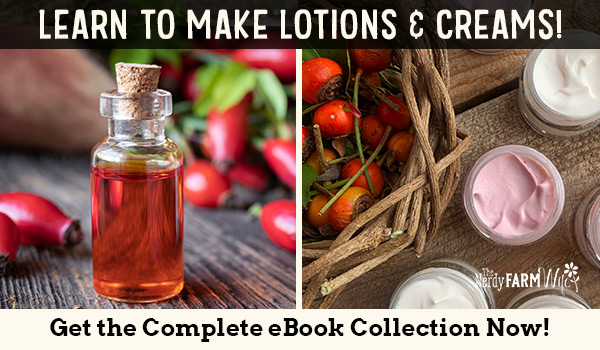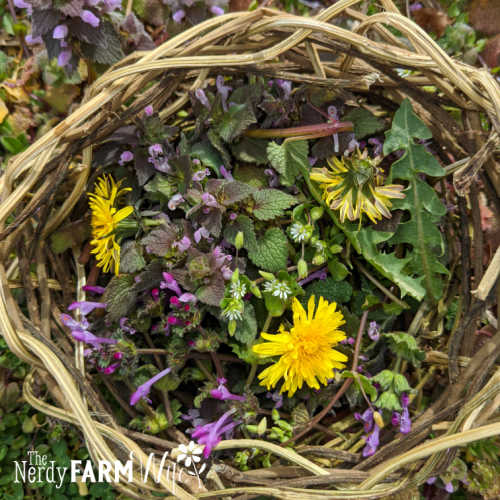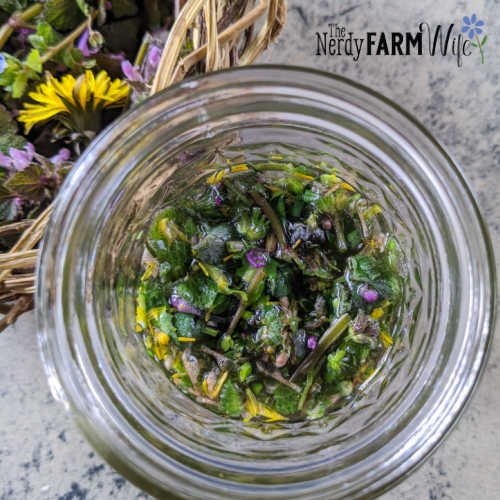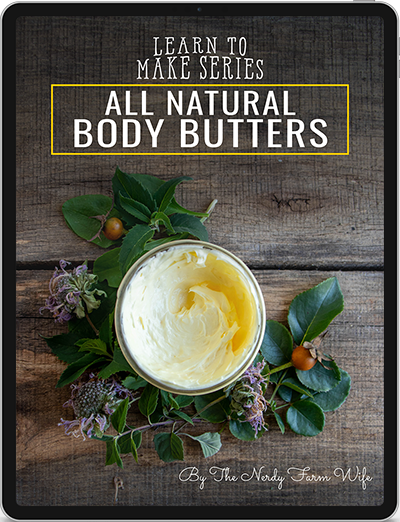Gardener’s Herbal Hand Cream
This moisturizing herbal hand cream is perfect for skin that’s rough, damaged, or dry from gardening, or working a lot with your hands.
It’s rich and thick, but soaks in nicely after a minute, to protect and repair your skin.
I especially love making this cream with weeds which have been gathered while prepping veggie beds.
Not only do they have beneficial properties, but it’s enjoyable to give them new life by turning them into a useful product!
Weeds to consider for this recipe:
- chickweed (Stellaria media)- soothes redness & chapped skin
- purple dead nettle (Lamium purpureum)- anti-inflammatory, anti-microbial
- henbit (Lamium amplexicaule) – some similarities with dead nettle
- dandelion flowers (Taraxacum officinale)- for sore or cracked skin
- violet flowers and leaves (Viola odorata, V. sororia )- soothing, moisturizing
- plantain (Plantago major) – heals damaged skin
and/or you could use other healing herbs, such as calendula, chamomile, elderflower, rose petals, or lavender.
To make this herbal hand cream, you’ll need to make both an infused oil and an infused tea. We’ll start with the oil first, since that takes the longest.
To make the infused oil:
You’ll need about twice as much oil as dried crumbled weeds such as dandelion, purple dead nettle, chickweed, violet leaves, plantain, etc.
Dry the weeds/herbs:
Pick and bring them indoors. Spread the plants in a single layer over a clean dishtowel or paper towel. Allow to air dry for several days until completely dry or use a dehydrator at 95 to 115 degrees F, for 1 to 4 hours, or until completely dry.
Fill a glass canning jar 1/4 to 1/2 of the way with the crumbled up dried weeds, then fill the jar almost to the top with your chosen oil and stir. Some good oil options include: apricot kernel, sunflower, olive, rice bran, sweet almond, or jojoba.
For a quick infusion:
Set the uncovered jar down into a saucepan containing a few inches of water, forming a makeshift double boiler of sorts. Place the pan over a low burner and heat for around 2 or 3 hours. Don’t allow the water to evaporate out of the pan, and monitor the oil while it’s heating. Remove from the heat and strain out enough oil for your recipe when needed. You can top off the jar with more oil and allow it to continue infusing the slow way until needed again.
For a slow infusion:
Instead of infusing over heat, put a lid on the jar and tuck it away in a cabinet or on a shelf and let it steep for at least 4 to 6 weeks, shaking occasionally as you remember to.
Strain and store any remaining infused oil in a dark spot or cabinet out of direct sunlight and heat. It’s great to use in lotion bar, salve, and lip balm recipes too. Shelf life should be about 1+ year.
For an in-depth resource about making lotions and creams from scratch, plus loads of helpful information about the best oils, butters, essential oils, herbs, flowers, and other natural ingredients to use for your skin type and needs, be sure to check out my Handmade Lotions & Creams eBook Collection!

To make the infused tea:
Place 1/4 cup freshly chopped weeds and herbs into a small heatproof jar or container. (Or, use half as much dried weeds/herbs.) Pour 1/2 cup simmering hot distilled water over the herbs and cover with a saucer or lid. Steep for 20 to 30 minutes, then strain.
You can use the tea right away to make your hand cream, or store it in the refrigerator for up to 24 hours, or freeze in ice trays for longer storage.
Now you’re ready to put everything together and make your herbal hand cream!
Gardener’s Herbal Hand Cream
Ingredients
Measurements are given in weights. You’ll need a scale that measures in grams (most kitchen scales do.) I use a little jeweler’s scale I found at LotionCrafter.
Water portion:
- 60 grams (2.12 oz) herbal tea (from above)
Oils & wax portion:
- 18 grams (0.63 oz) infused oil (from above)
- 12 grams (0.42 oz) mango, shea, or other butter (I used murumuru in this batch)
- 7 grams (0.25 oz) emulsifying wax (I use the e-wax from Mountain Rose Herbs)
- 2 grams (0.07 oz) beeswax (or use more butter instead, if vegan)
Add-ins:
- 1 gram Geogard ECT (Benzyl Alcohol, Salicylic Acid, Glycerin, and Sorbic Acid) – also called Preservative ECO or Plantaserv M. (A natural-compliant & organic-friendly preservative.)
- Optional: 10 drops essential oil (sweet orange or lavender are two good choices)
Directions to Make
Weigh out the herbal tea into a heatproof container. I like to use small jelly/canning jars. Cover this jar with a lid, to keep the tea from evaporating while it heats.
Weigh out the infused oil, cosmetic butter of your choice, emulsifying wax, and beeswax in a separate heatproof container.
Place the two containers down into a saucepan containing an inch or so of water, forming a double boiler of sorts. Turn the burner to medium low and heat until the butter and wax is fully melted. (About 20 to 25 minutes.) Remove from heat when melted.
Carefully – since the jars are hot at this point! – pour the hot liquid and oils together and stir, stir, stir.
I often use a fork to stir, but you could also dump the two mixtures into a wide mouth canning jar, and mix them with one beater of a standard hand mixer.
Stir frequently until the lotion starts to thicken as it cools. To speed things up, I always set the jar down into a bowl of ice water while stirring – once the jar has cooled down a bit. (Don’t plunge a piping hot jar into ice water though, or it may crack.)
Once cooled to below 104°F (40°C) , stir in the preservative and essential oil, if using. Pour into containers or jars. Depending on your brand of emulsifying wax, it will likely thicken more over the next 24 hours.
If there’s another preservative you’d like to use instead: Check the usage rates listed on your vendor’s website, adjusting the water amount a little bit if needed. (Geogard ECT is used at 1%, similar to Optiphen Plus.)
If you want to leave out the preservative: Keep your cream refrigerated and use it up within a week.







Your timing is perfect. I have all of these “weeds” at the ready in my yard and boy do my hands ever need a good lotion! I have your book and am happily making and using many of your fantastic recipes. Thankfully its ok to use the dehydrator for the chickweed and purple dead nettle etc. wont loose their healing qualities in the short drying time. So thank-you in advance for sharing this new botanical oil and infusion lotion.
So happy that the recipe came at a good time & that you’re enjoying the book! Have a wonderful time with your treasure of weeds! ❤
Thanks Jan, I look forward to making some of the products you feature on your site!
Hi Joan! So happy you like the recipes! ❤
Hello Jan,
I was wondering if keeping the lotion in the freezer would help the ‘shelf life’ of the cream? I made some cream but did not put preservatives in it. Thank you!
Hi Carol! I’ve experimented with freezing lotion in small portions for up to a month and it held up pretty well. It was a short term experiment though – I’m not sure how it would do for long term, but you could try freezing a few small portions and see how it goes! :)
Thank you Jan! I want to try this out but wondering what the consistency of the cream is? Is it fairly thick like a body butter or more like a lotion? I am wanting to make a hoof conditioner for my horses out of natural ingredients to tackle the dryness – something that’s as thick as or slightly thicker than body butter
Hi Chandni! The texture is like a thick lotion, but it’s thinner than body butter. I’m not experienced with horses, but I don’t think this recipe would be what you’re looking for.
What you could do is find a natural commercial product with good reviews and then check out the ingredient list for inspiration.
For example: https://www.smartpakequine.com/pt/absorbine-hooflex-all-natural-dressing-7033
is made with Soybean Oil, Castor Oil, Lanolin, Avocado Oil, Tea Tree Oil, Arnica Extract and Comfrey Extract (maybe infuse the oils with these herbs instead?)
Beeswax would thicken it, though this article warns against using too much wax:
https://www.equisearch.com/articles/hoof-dressing-choices-for-all-hoof-types
I’m not a good source of information on this topic, but hopefully you can find a great recipe out there! ?
Hi Jan, I have found a natural conditioner that contains similar ingredients to your hand cream. However, it is not easy to find and must be imported from UK. I’m just trying to see if I can create something similar since it is working so well :) It has the consistency of thick body butter and includes beeswax, shea butter, aloe, water and some other oils. I’m also wondering if it is possible to incorporate glycerin into your recipe and how you would do that. I just found your blog recently, so excited to try some of these recipes!!
I have tried the hoof conditioners you mentioned but haven’t had much luck with them, that’s why I’m now on a quest to try to make my own :D
Hi Chandni! That sounds like a great plan! :) You could try reducing the water amount in this recipe and you’ll get a thicker texture.
Replace the missing water with more oil and butter, and a bit more wax to help emulsify it.
Glycerin can be used in place of water; too much will feel sticky, so perhaps try starting with 3 or 4%.
So the new test recipe might look something like this:
4 grams glycerin
46 grams herbal tea
22 grams infused oil
17 grams butter
8 grams emulsifying wax
2 grams beeswax
1 gram preservative
If that’s still too thin, then an increase in beeswax and/or butter and even less water should help!
You can keep tinkering with the amounts of ingredients, just shift things around so the total weight of ingredients adds back up to 100 grams.
Best of luck with your quest! :)
Thank you!! :)